FINDING LIMITS FROM A GRAPH PRACTICE FOR AP CALCULUS BC
Subscribe to our ▶️ YouTube channel 🔴 for the latest videos, updates, and tips.
Problem 1 :
The graph of the function f is shown. Which of the following statements about f is true ?
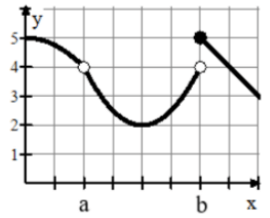
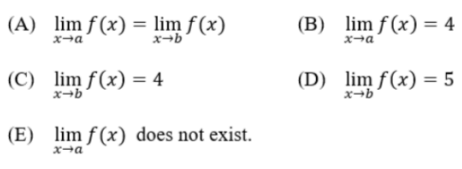
Option A :
lim x -> a f(x) = 4
Approaching b from left side, we get 4
Approaching b from right side, we get 5. Which means
lim x -> b f(x) = undefined
lim x -> a f(x) = 4 ≠ lim x -> b f(x)
So, it is false.
Option B :
lim x -> a- f(x) = 4 and lim x -> a+ f(x) = 4
So, lim x -> a f(x) = 4. Then it is true.
Option C :
lim x -> b f(x) = 4 and lim x -> b f(x) = 5
Then it is false.
Option D :
It is false.
Option E :
lim x -> a- f(x) = lim x -> a+ f(x) = 4
The given says does not exists. So, it is false.
So, answer is option B.
Problem 2 :
The figure below shows the graph of a function f with domain 0 ≤ x < 6. Which of the following statements are true ?
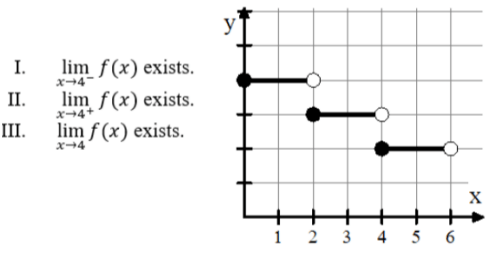

Solution :
lim x -> 4- f(x) = 3
lim x -> 4+ f(x) = 2
lim x -> 4 f(x) = does not exists.
So, the answer is C.
Problem 3 :
The graph of the function f is shown below. For which of the following values of c does lim x -> c f(x) = 2 ?
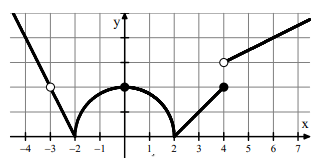

Solution :
lim x -> c f(x) = 2
The output is 2, when x = -3 and 0. So, option C is correct.
Problem 4 :
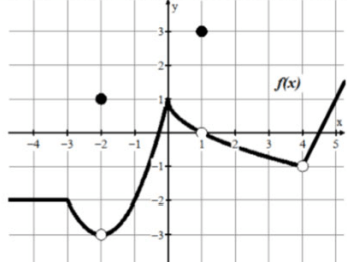
Evaluate each of the following from the above graph :
1) f(-2) =
2) lim x->-2 f(x) =
3) f(1) =
4) f(4) =
5) lim x->-4 f(x) =
6) lim x->0 f(x) =
Solution :
1) f(-2) = 1
2) lim x->-2 f(x)
Tracing the function, we get -3. So, the value lim x->-2 f(x) = -3.
3) f(1) = 3
4) f(4)
At x = 4, we don't see the filled circle. The curve does not pass through any point, so it is undefined.
So, f(4) = undefined.
5) lim x->-4 f(x) = -2
6) lim x->0 f(x) = 1
Because the curve passes through the point (0, 1).
Problem 5 :
Let f be the function that is defined for all real numbers x. Of the following, which is the best representation of the statement lim x -> 4 f(x) = 8.
a) The value of the function f at x = 4 is 8.
b) The value of the function f at x = 8 is 4.
c) As x approaches 4, the values of f(x) approach 8.
d) As x approaches 8, the values of f(x) approach 4.
Solution :
c) As x approaches 4, the values of f(x) approach 8.
Problem 6 :
The function f satisfies lim x->3 f(x) = 6. Which of the following could be the graph of f ?
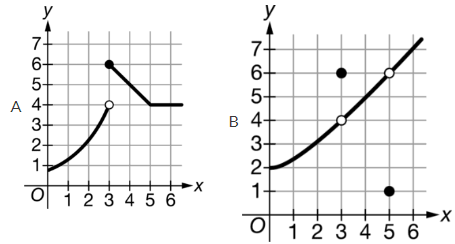
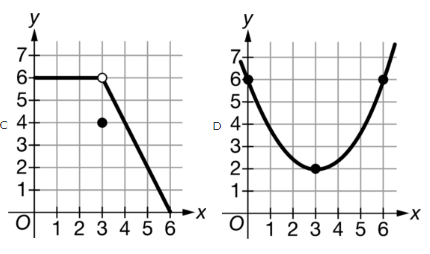
Solution :
Option A :
lim x->3- f(x) = 4 and lim x->3+ f(x) = 6. So, lim x->3 f(x) = does not exists. Option A is incorrect.
Option C :
lim x->3- f(x) = 6 and lim x->3+ f(x) = 6. So, lim x->3 f(x) = 6.
f(3) = 4.
So, option C is correct.
Problem 7 :
In order for the line y = a to be a horizontal asymptote of h(x), which of the following must be true?
A) limx→a+ h(x) = ∞ B) limx→a− h(x) = −∞
C) limx→∞ h(x) = ∞ D) lim x→−∞ h(x) = a
E) lim x→−∞ h(x) = ∞
Solution :
The output is a. Since there is a horizontal asymptote, x approaches +∞ and - ∞, the output is a. So, the answer is
D) lim x→−∞ h(x) = a
Subscribe to our ▶️ YouTube channel 🔴 for the latest videos, updates, and tips.
Recent Articles
-
Finding Range of Values Inequality Problems
May 21, 24 08:51 PM
Finding Range of Values Inequality Problems -
Solving Two Step Inequality Word Problems
May 21, 24 08:51 AM
Solving Two Step Inequality Word Problems -
Exponential Function Context and Data Modeling
May 20, 24 10:45 PM
Exponential Function Context and Data Modeling